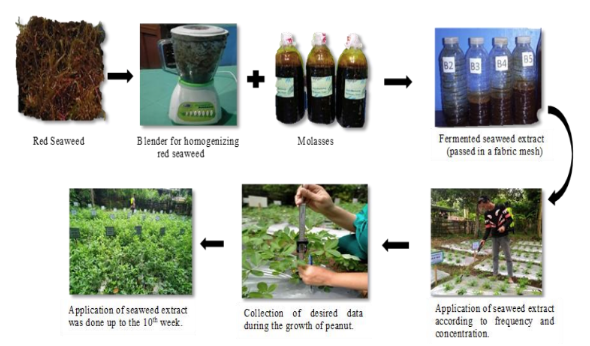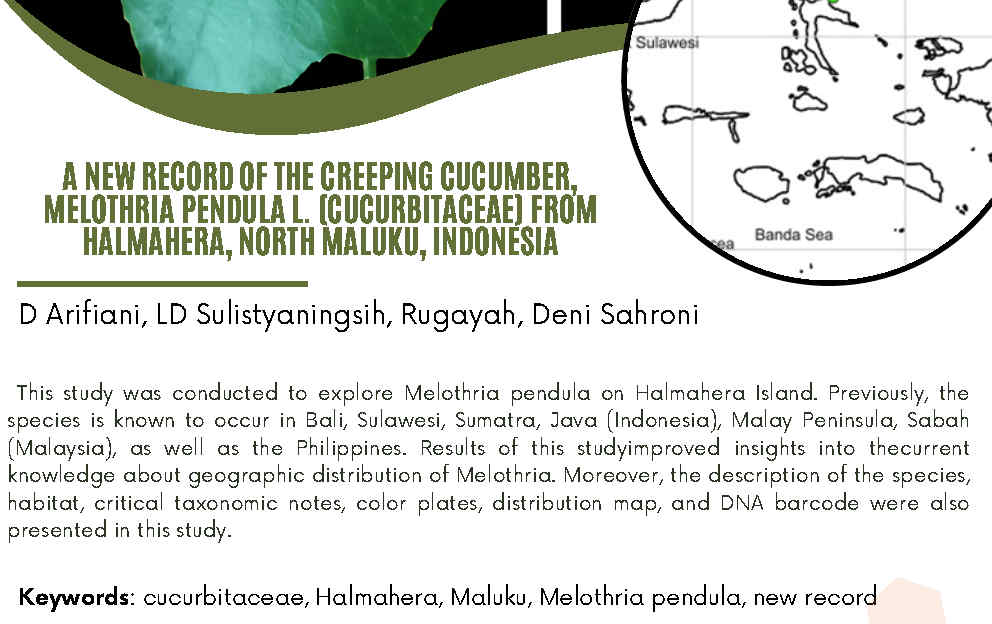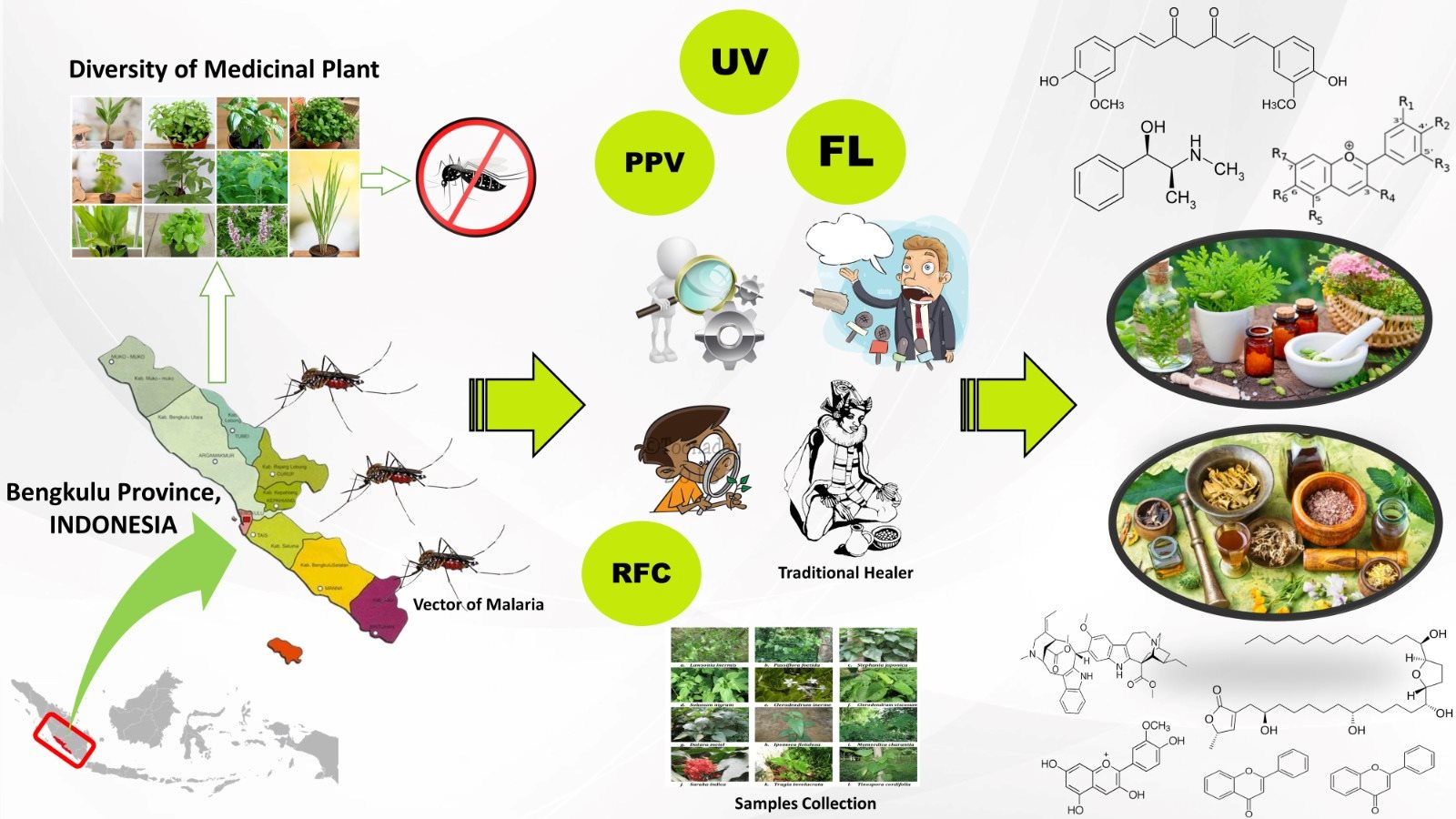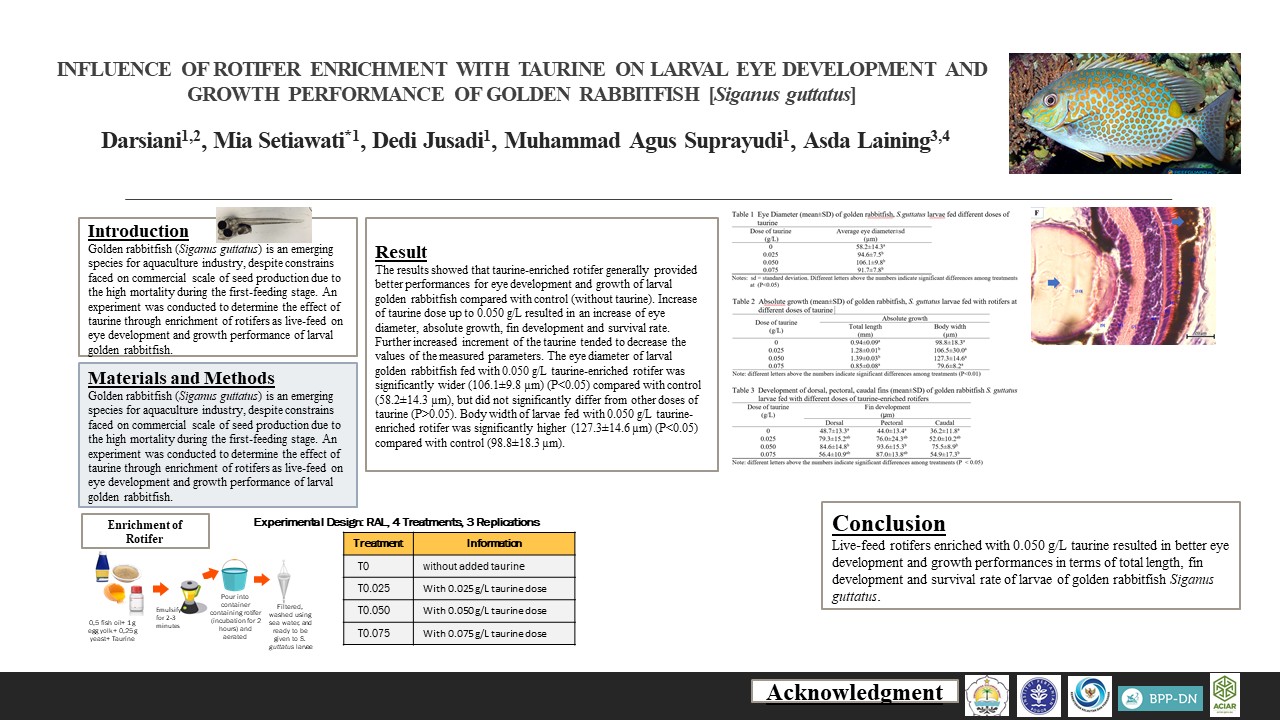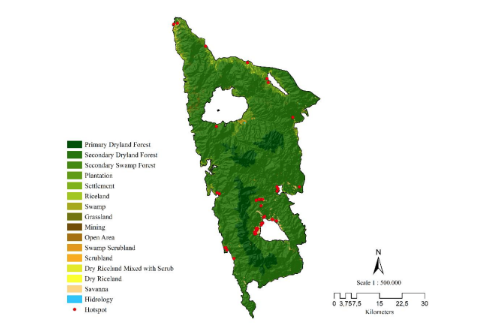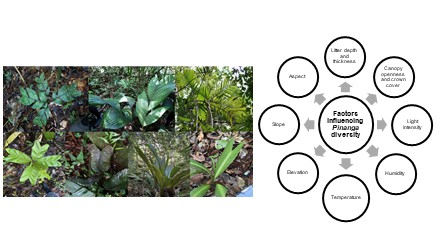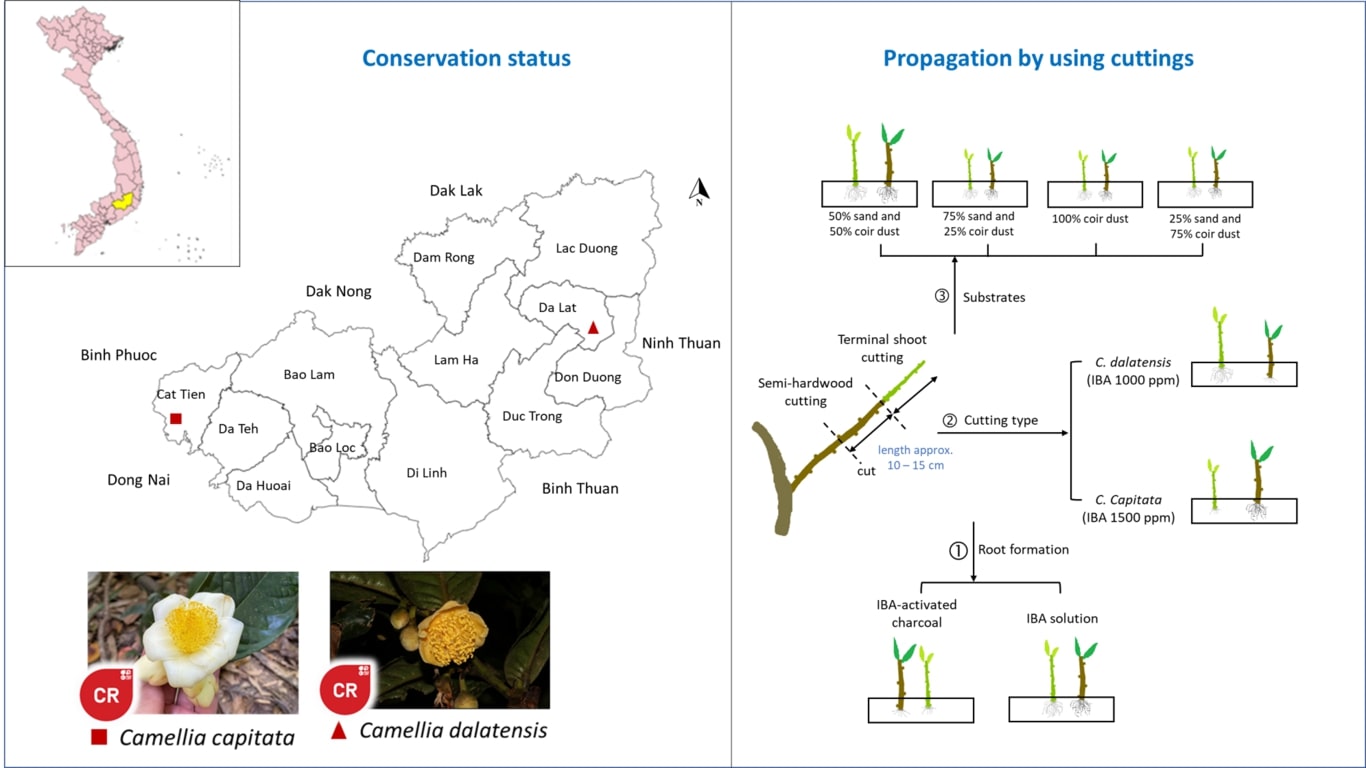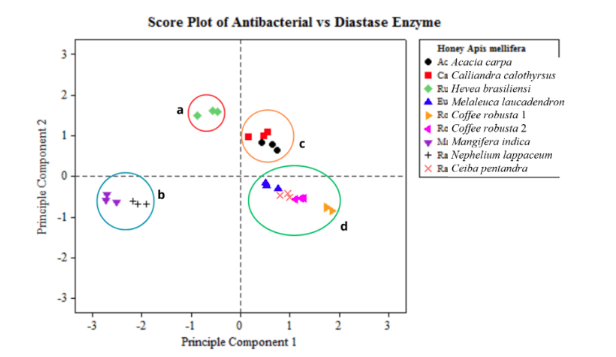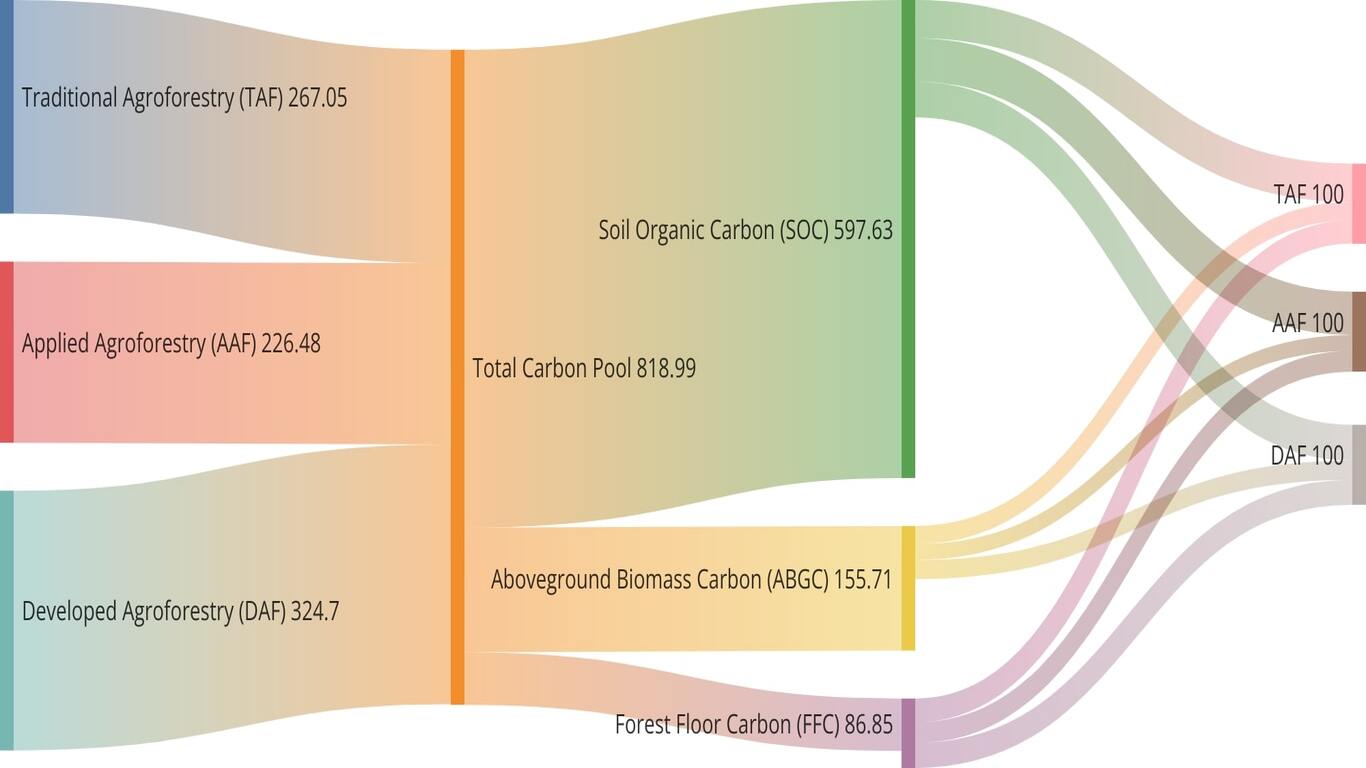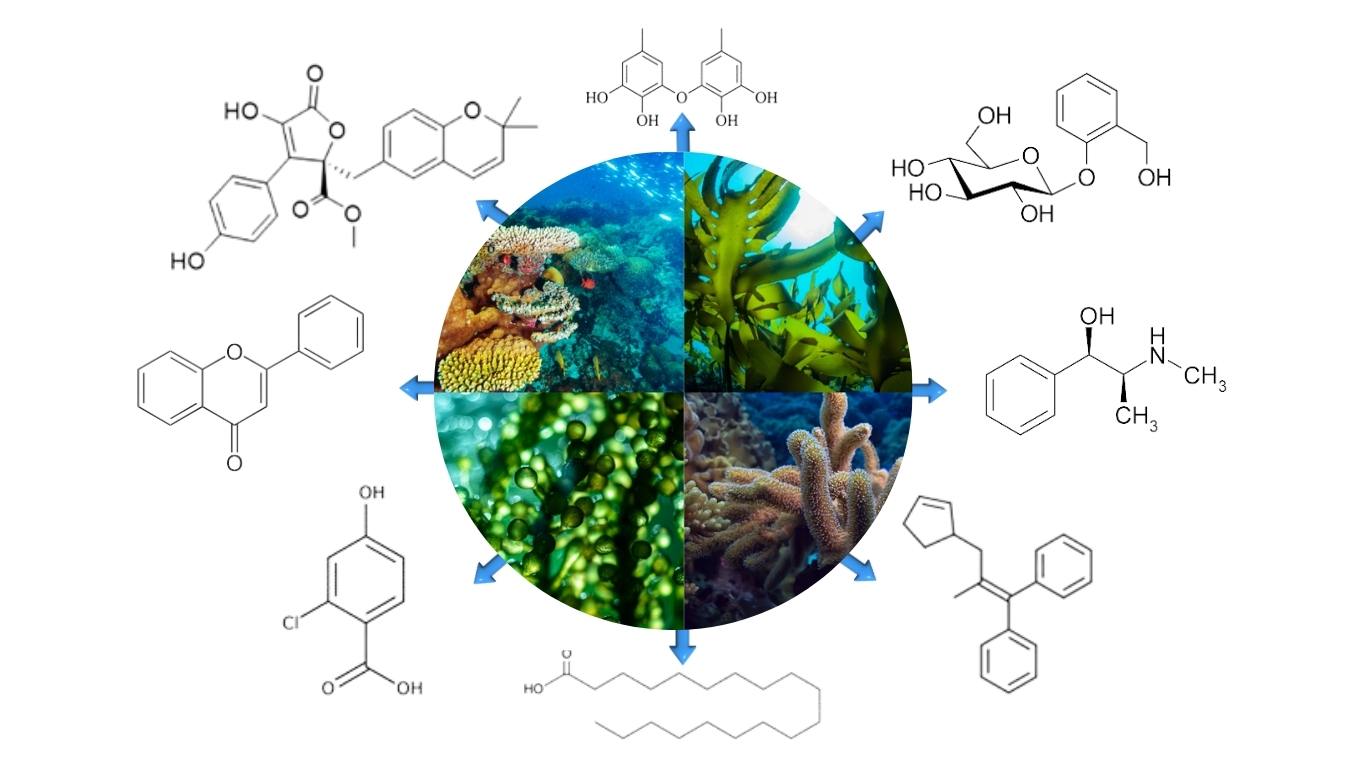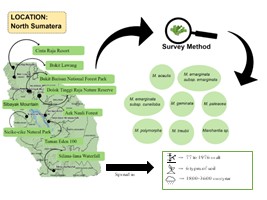TREE SPECIES DIVERSITY AND MANAGEMENT IN AGROFORESTRY POHPOHAN (Pilea melastomoides)
THE CASE IN THE TRADITIONAL ZONE OF GUNUNG HALIMUN SALAK NATIONAL PARK, INDONESIA
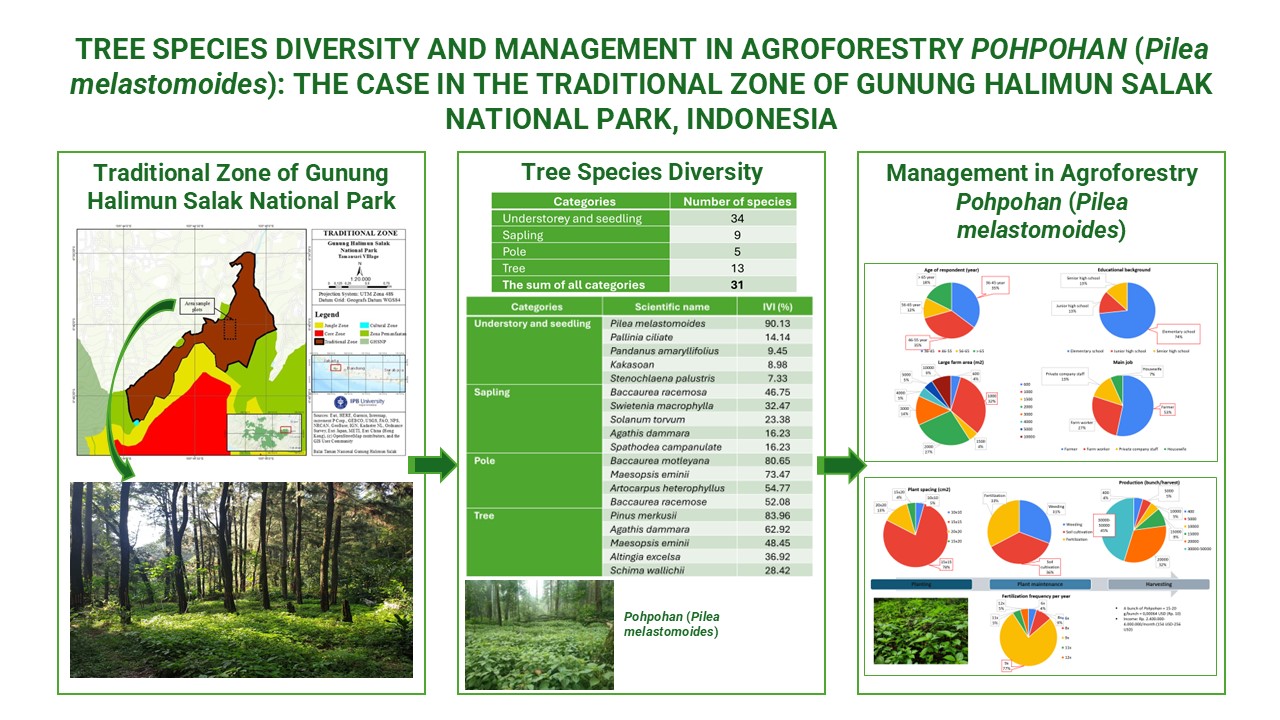
Downloads
Article Highlights
- Pohpohan (Pilea melastomoides) is the main commodity cultivated by using traditional agroforestry in the traditional zone of Gunung Halimun Salak National Park as a fresh vegetable.
- There is a limited database of plant species diversity in the traditional zones, which is dynamic and needs further research.
- This study found 54 tree species from 37 families with the dominant family being Rubiaceae.
- Most farmers cultivated Pohpohan by conducting plant spacing, maintenance, and harvesting. Their income is USD 154 – 256/month.
Abstract
Gunung Halimun Salak National Park (GHSNP) is Java's largest tropical mountain forest. GHSNP is still facilitating community grounds around GHSNP with the existence of a traditional zone. Pohpohan (Pilea melastomoides) is the primary commodity in the traditional zone cultivated by the local people around GHSNP. Pohpohan is planted using traditional agroforestry planting patterns. The traditional zone has a limited plant species diversity and management database, so further study is necessary. This study was conducted in the traditional zone of GHSNP, specifically at the agroforestry system in Tamansari Village, Bogor Regency. Data collection of tree diversity was conducted by establishing 25 plots. This study also interviewed 30 local farmers belonging to the Mandiri farmer group. There are 54 species from 37 families. Rubiaceae, Malvaceae, Fabaceae, and Phyllanthaceae families are the most common families. Pinus merkusii, Agathis dammara, and Maesopsis eminii have the highest important value index (IVI) values. Understorey and seedlings have a low category on H' due to the dominant planting of Pohpohan. Most respondents are people aged 35-55 (70%) with a farming area of 1000 m2. They cultivate Pohpohan by conducting plant spacing, plant maintenance (e.g., soil cultivation, weeding, fertilization), and harvesting. Most farmers conduct fertilization 9 times/year. Farmers produce 30.000-50.000 bunches/harvest. The price of a bunch of Pohpohan is 0,00054 USD. Their income is about 154 USD – 256 USD/month.
Downloads
Adalina Y. 2014. Implikasi modal sosial masyarakat terhadap pengelolaan taman nasional (Studi kasus Taman Nasional Gunung Halimun Salak) [The implications of community social capital on national park management (A case study of Gunung Halimun Salak National Park)]. [Dissertation]. Bogor (ID): Institut Pertanian Bogor.
Adalina Y, Nurrochmat DR, Darusman D, Sundawati L. 2014. Harvesting of non-timber forest products by the local communities in Mount Halimun-Salak National Park, West Java, Indonesia. JMHT 20(2):103-11. DOI: 10.7226/jmht.20.2.103 DOI: https://doi.org/10.7226/jtfm.19.2.103
Adhiningsih L, Basuni S, Munawir A, Hidayati S, Hartoyo APP, Sunkar A. 2022. Sustainable utilizations of Pohpohan (Pilea melastomoides (Poir.) Wedd) in Tamansari Village, West Java- Indonesia. IOP Conf. Ser: Earth Environ Sci 1109:012091. DOI: 10.1088/1755-1315/1109/1/012091 DOI: https://doi.org/10.1088/1755-1315/1109/1/012091
[BTNGHS] Balai Taman Nasional Gunung Halimun Salak. 2021. Statistik Balai Taman Nasional Gunung Halimun Salak Tahun 2020 [2020 Statistics of Gunung Halimun Salak National Park]. Sukabumi (ID): Balai Taman Nasional Gunung Halimun Salak.
Darusman D. 2000. Dimensi Kemasyarakatan dalam Pengelolaan Hutan [Social Dimensions in Forest Management]. Bogor (ID): Institut Pertanian Bogor.
Ekayani M, Nuva, Rizqiyyah Y, Sinaga F, Maaruf LOM. 2014. Wisata alam Taman Nasional Gunung Halimun Salak: Solusi kepentingan ekologi dan ekonomi [Ecotourism in Gunung Halimun Salak National Park: A solution for ecological and economic interests]. JIPI 19(1):29-37.
[GHSNMP-JICA] Gunung Halimun Salak National Mountain Park-Japan International Cooperation Agency. 2007. Gunung Halimun Salak National Park, The Misty Mountains of Halimun Salak. Sukabumi (ID): Gunung Halimun Salak National Park.
Hartoyo APP, Kairunnisa S, Pamoengkas P, Solihkin A, Supriyanto, Siregar IZ, Prasetyo LB, Istomo. 2022. Estimating carbon stocks of three traditional agroforestry systems and their relationships with tree diversity and stand density. Biodiversitas 23(12):6137-46. DOI: 10.13057/biodiv/d231207 DOI: https://doi.org/10.13057/biodiv/d231207
Hendarti L. 2008. Menepis Kabut Halimun: Rangkaian Bunga rampai pengelolaan sumber daya alam [Dispelling the Halimun Mist: A collection of essays on natural resource management. Jakarta (ID): Yayasan Obor Indonesia.
Hilwan I, Irfani E. 2018. Pola penyebaran dan regenerasi jenis saninten (Castanopsis argentea Blume) di Resort Selabintana, Taman Nasional Gunung Gede Pangrango [Distribution pattern and regeneration of saninten species (Castanopsis argentea Blume) in Selabintana Resort, Gunung Gede Pangrango National Park]. J Silvikultur Tropika 9(1):53-9. DOI: https://doi.org/10.29244/j-siltrop.9.1.53-59
Hilwan I, Mulyana D, Pananjung WG. 2013. Keanekaragaman jenis tumbuhan bawah pada tegakan sengon buto (Enterolobium cyclocarpum Griseb.) dan trembesi (Samanea saman Merr.) di lahan pasca tambang batubara PT Kitadin, Embalut, Kutai Kartanegara, Kalimantan Timur [Diversity of understory plant species in sengon buto (Enterolobium cyclocarpum Griseb.) and trembesi (Samanea saman Merr.) stands on post-coal mining land at PT Kitadin, Embalut, Kutai Kartanegara, East Kalimantan. J Silvikultur Tropika 4(1):6-10.
Ibadurrohmah N. 2016. Pola penyebaran dan regenerasi puspa (Schima wallichii (DC.) Korth.) di Resort Selabintana Taman Nasional Gunung Gede Pangrango [The distribution patterns and regeneration of puspa (Schima wallichii (DC.) Korth.) in the Selabintana Resort of Gunung Gede Pangrango National Park]. [Theses]. Bogor (ID): Institut Pertanian Bogor.
Indriyani L, Flamin A, Erna E. 2017. Analisis keanekaragaman jenis tumbuhan bawah di Hutan Lindung Jompi [Analysis of the diversity of understory plant species in the Jompi Protected Forest]. J Ecogreen 13(1):49-58.
Indriyanto. 2015. Ekologi hutan [Forest ecology]. Jakarta (ID): PT Bumi Aksara.
Ismail MH, Fuad MFA, Zaki PH, Jemali NJN. 2017. Analysis of importance value index of unlogged and logged peat swamp forest in Nenasi Forest Reserve, Peninsular Malaysia. Bonorowo Wetlands 7(2):74-8. DOI: 10.13057/bonorowo/w070203 DOI: https://doi.org/10.13057/bonorowo/w070203
Jørgensen SE, Costanza R, Xu FL. 2005. Handbook of ecological indicators for assessment of ecosystem health. Boca Raton (US): CRC Press. DOI: https://doi.org/10.1201/9780203490181
Karim SN. 2017. Komposisi dan struktur tegakan hutan alam di areal kerja IUPHHK-HA PT Ratah Timber Kalimantan Timur [Composition and structure of natural forest stands in the working area of IUPHHK-HA PT Ratah Timber, East Kalimantan]. [Theses]. Bogor (ID): Institut Pertanian Bogor.
Kawulich BB. 2005. Participant observation as a data collection method. FQS 6(2). DOI: 10.17169/fqs-6.2.466
Magurran AE. 2004. Measuring biological diversity. Oxford (UK): Blackwell Publishing.
Margalef R. 1972. Homage to Evelyn Hutchinson, Or Why There is an Upper Limit to Diversity?. New Heaven (US): Connecticut Academy of Arts and Sciences.
Olivi R, Qurniati R, Firdasari. 2015. Kontribusi agroforestri terhadap pendapatan petani di Desa Sukoharjo 1 Kecamatan Sukoharjo Kabupaten Pringsewu [The contribution of agroforestry to farmer income in Sukoharjo 1 Village, Sukoharjo District, Pringsewu Regency]. J Sylva Lestari 3(2):1-12. DOI: 10.23960/jsl231-12 DOI: https://doi.org/10.23960/jsl231-12
Putri SM, Indriyanto. 2021. Keanekaragaman tumbuhan penyusun vegetasi hutan lindung Bengkunat di Resor III KPH Unit I Pesisir Barat [Diversity of plant species in the protective forest vegetation of Bengkunat in Resort III Unit Management of I Pesisir Barat] J Hutan Tropis 9(1):212-21. DOI: 10.20527/jht.v9i1.10496 DOI: https://doi.org/10.20527/jht.v9i1.10496
Rahayu GA, Buchori D, Hindayana D, Rizali A. 2017. Keanekaragaman dan peranan fungsional serangga pada area reklamasi pascatambang batubara di Berau, Kalimantan Timur [Diversity and functional roles of insects in post-mining coal reclamation areas in Berau, East Kalimantan]. J Entomologi Indonesia 14(2):97-106. DOI: 10.5994/jei.14.2.97 DOI: https://doi.org/10.5994/jei.14.2.97
Rahmawati R, Subair, Idris, Gentini, Ekowati D, Setiawan U. 2008. Pengetahuan lokal masyarakat adat Kasepuhan: Adaptasi konflik, dan dinamika sosio-ekologis [Local knowledge of the Kasepuhan indigenous community: Adaptation, conflict, and socio-ecological dynamics]. J Transdisiplin Sosiologi, Komunikasi, dan Ekologi Manusia 2(2):151-90. DOI: 10.22500/sodality.v2i2.5886 DOI: https://doi.org/10.22500/sodality.v2i2.5886
Rawana, Wijayani S, Masrur MA. 2022. Indeks nilai penting dan keanekaragaman komunitas vegetasi penyusun hutan di Alas Burno SUBKPH Lumajang [Importance value index and diversity of vegetation community components in the Alas Burno Forest, SUBKPH Lumajang]. J Wana Tropika 12(2):80-9. DOI: 10.55180/jwt.v12i02.215 DOI: https://doi.org/10.55180/jwt.v12i02.215
Reed MS, Graves A, Dandy N, Posthumus H, Hubacek K, Morris J, …, Stringer LC. 2009. Who’s in and why? A typology of stakeholders analysis methods for natural resource management. J Environ Manage 90(5):1933-49. DOI: 10.1016/j.jenvman.2009.01.001 DOI: https://doi.org/10.1016/j.jenvman.2009.01.001
Sari DP, Lestari DI, Saputra A, Prabowo CA, Harlita. 2022. Keanekaragaman avifauna daerah terbuka dan tertutup di wilayah Kampus Kentingan Universitas Sebelas Maret [Diversity of avifauna in open and closed areas in the Ketingan Campus area of Universitas Sebelas Maret]. BIOMA 7(1):56-67. DOI: 10.20956/bioma.v7i1.19294 DOI: https://doi.org/10.20956/bioma.v7i1.19294
Simpson EH. 1949. Measurement of diversity. Nature 163:688. DOI: 10.1038/163688a0 DOI: https://doi.org/10.1038/163688a0
Smith GT. 1977. The effect of environmental change on six rare birds. Emu-Austral Ornithology 77(4):173-79. DOI: 10.1071/MU9770173 DOI: https://doi.org/10.1071/MU9770173
Soerianegara I. 1996. Ekologi, Ekologisme dan Pengelolaan Sumberdaya Hutan [Ecology, Ecologism, and Forest Resource Management]. Bogor (ID): IPB Press.
UNESCO. 2009. Learning and knowing in indigenous societies today. Bates P, Chiba M, Kube S, Nakashima D (Editors). Paris (FR): UNESCO. 128 p.
Wahyuningsih E, Faridah E, Budiadi, Syahbudin A. 2019. Komposisi dan keanekaragaman tumbuhan pada habitat ketak (Lygodium circinatum (Burm. (SW.)) di Pulau Lombok, Nusa Tenggara Barat [Composition and diversity of plants in the habitat of ketak (Lygodium circinatum (Burm. (Sw.)) on Lombok Island, West Nusa Tenggara]. J Hutan Tropis 7(1):92-105. DOI: 10.20527/jht.v7i1.7285
Copyright (c) 2024 Adisti Permatasari

This work is licensed under a Creative Commons Attribution-NonCommercial-NoDerivatives 4.0 International License.
Authors who publish with this journal agree with the following terms:
- Authors retain copyright and grant the journal right of first publication, with the work 1 year after publication simultaneously licensed under a Creative Commons attribution-noncommerical-noderivates 4.0 International License that allows others to share, copy and redistribute the work in any medium or format, but only where the use is for non-commercial purposes and an acknowledgement of the work's authorship and initial publication in this journal is mentioned.
- Authors are able to enter into separate, additional contractual arrangements for the non-exclusive distribution of the journal's published version of the work (e.g., post it to an institutional repository or publish it in a book), with an acknowledgement of its initial publication in this journal.
- Authors are permitted and encouraged to post their work online (e.g., in institutional repositories or on their website) prior to and during the submission process, as it can lead to productive exchanges, as well as earlier and greater citation of published work (See The Effect of Open Access).









